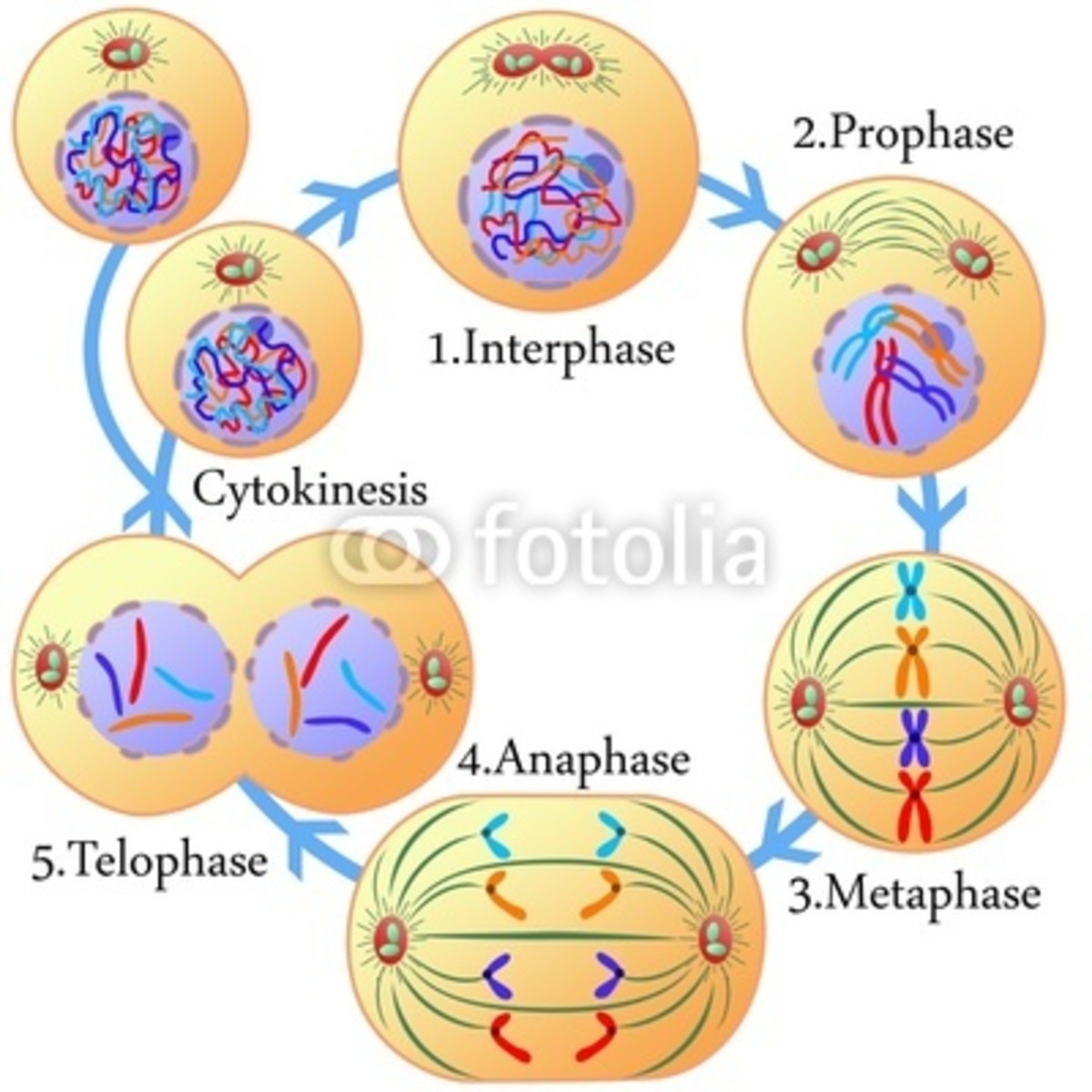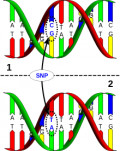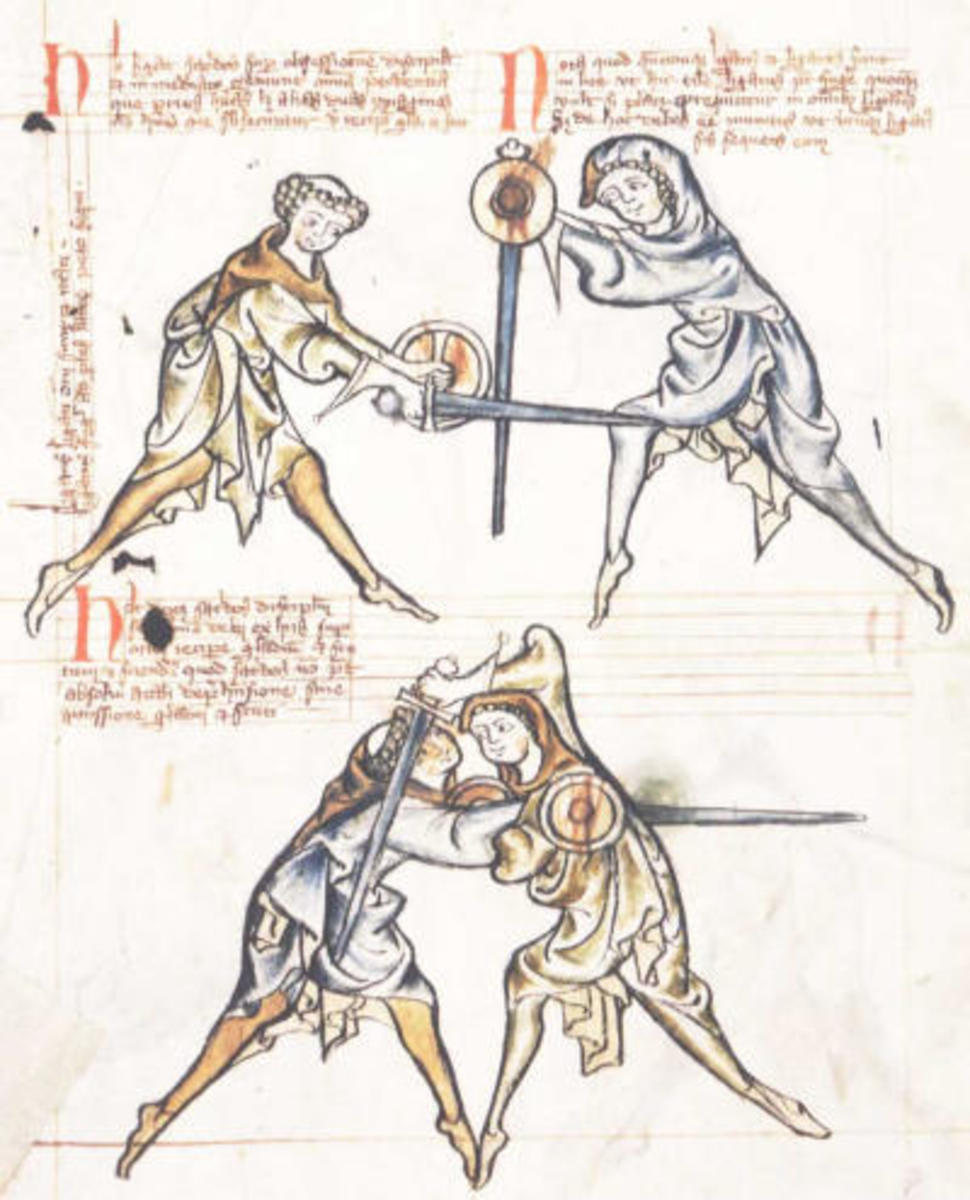How to Use Human Genetics in Fiction
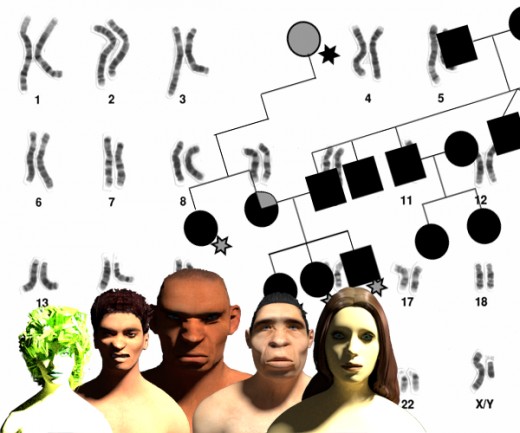
Intro
All humans have genes so this could be relevant to pretty well any genre (including literary fiction) that involves humans although it's probably more often relevant for science fiction and fantasy. This is an issue that's often important in fiction but writers frequently make mistakes. For example in an episode of Terminator: The Sarah Conner Chronicles it was said that Sarah's blood type was O and John, her biological son, was type AB. This isn't quiet impossible but it's really close to it! It's interesting to note that although this is a science fiction series the mistake related to a real, and well known, gene!
Although this is primarily about humans, most of this applies to nearly all mammals (probably including elves, unicorns and aliens who can interbreed with humans) and a lot of it applies to all diploid eukaryotes (insects, flowering plants and probably dinosaurs and dragons).
The main uses of human genetics in fiction are:
-
Biologically related characters with genetic characteristics.
-
Mystery with genetic evidence.
-
Use of possibly dubious genetic arguments to make legal or political points including about discrimination.
-
Genetically distinct groups interbreeding.
This article isn't going to deal with mutant or genetically engineered monsters or supers as you're usually not interested in the technicalities, just what they can do and how to kill them.
Definitions
Gene – position in the genome where there's sometimes a sequence with a function.
Allele – version of a gene (may or may not do something, such as coding for a protein, but at least one allele of a given gene must do something).
Marker – rare DNA sequence, may not do anything but helps to determine relationships.
Alien – a being from space or a parallel universe (thought I should clarify that).
Human races – generally accepted, real, extant races. NOT elves, Neanderthals, cryptids, aliens etc.
Modification – related to epigenetics.
H. sapiens – modern human (as opposed to Neanderthals etc.). Neanderthals are sometimes considered a subspecies of H. sapiens rather than a separate species but this is a largely semantic argument I'm not going to address.
Male/Man – has XY sex chromosomes.
Female/Woman – has XX sex chromosomes.
I know there are exceptions to the last two but this article isn't dealing with them to avoid having to put in lots of caveats whenever sex is mentioned. If your story involves the genetics of a transexual or somebody with Turner's syndrome or something, do the required research, common sense is sometimes wrong.
Can have alleles that work differently in different sexes or interact with alleles of other genes.
Justifying discrimination
Unfortunately genetics is sometimes used to justify treating groups differently. Sometimes there's good reason for this, for example you probably shouldn't give milk to people from a group which is mostly lactose intolerant.
Some differences between groups are statistical; for example something is true of 5% of one group and 10% of another. Statistics can be confusing and can be misused: lies dam lies and statistics! Usually only the characteristics of the individual you're dealing with are important to you. Some things may not be obvious until they bite you, particularly in a long term relationship (e.g. extremist family members or a genetic disorder that only appears late in life) but that sort of thing could be true of anybody (anybody could convert to a different religion and become a fanatic).
There are several common grounds for discrimination:
Sex – There are clear genetic, physical and mental differences between the sexes but the extent and importance, particularly of mental differences, are debatable. There are arguments about whether mental differences are genetic or environmental. Statistical differences may be due to X-linked genes. It's claimed that the Myers-Briggs T factor (logical and unemotional personality type) occurres in 60% of men and 35-40% of women. This means the proportion of females is about the proportion of males squared, consistent with a recessive X-linked allele.
Race – Although genetics has been used to justify racism it really shows racial differences to be vague and trivial. Some people go so far as to claim that H. Sapiens doesn't really have races, at least not living ones. However you really need a term for those groups who've historically lived in different areas and look different. Therefore GENETICS DOES NOT SUPPORT RACISM! (This of course assumes we're talking about human races as defined above. Otherwise things may be different.)
Orientation - Unclear if sexual orientation has a genetic basis. Identical twins can have different orientations. It's thought this may involve epigenetics.
Rare characteristics – Psychic powers, magic, superhuman mutants. This is rare in real life (it's likely that witch hunters didn't target real witches) but is often used in fiction. Here the characteristic is often of real relevance so muggles may have real reasons to fear wizards.
Religion - not genetic but tends to correlate with race and geography. A small, hereditary, religious group may be genetically distinct. Being Jewish has both a religious and a hereditary component. A religion may attract converts with certain alleles.
Isolated groups (e.g. inhabitants of Tahiti, Samaritans, some families) - tend to have high levels of rare alleles due to inbreeding. Any isolated group will be statistically different from it parent population to start with, will eliminate alleles by chance or selection, recessive characteristics will become commoner, may interbreed with another group, acquire mutations and rare alleles may become common, the group basically evolving away from the parent population. The parent population will probably evolve more slowly and likely in a different direction. This may result in genetically strange, but usually small, groups within a race or religion (may be all of a small, hereditary religious group). This is likely to happen with human colonies in space or isolated groups on earth after an apocalypse, possibly to a far greater extent.
Genetic arguments for or against discrimination may get awkward if your discriminated-against group are psychics or aliens etc. Some groups (e.g. werewolves and vampires) are inherently prone to killing people. All human races are completely inter-fertile but this probably won't apply to aliens and the collapse of the human population due to large scale intermarriage and interbreeding may be a serious issue.
THINK THROUGH YOUR PERSECUTED MINORITY GROUP ANALOGS!
Epigenetics
Definition: Modifications to DNA or related structures (not changes to base sequences) that control gene expression. Modification occurres in response to something and is itself determined by genetics so it may not be the same in everybody.
Epigentics is important in cellular differentiation. It's sometimes affected by the environment. Modifications can be passed onto offspring to an extent (so Lamarckism, the theory that acquired characteristics can be passed onto offspring, is not complete rubbish after all). It's involved in some diseases, including cancer and psychological problems.
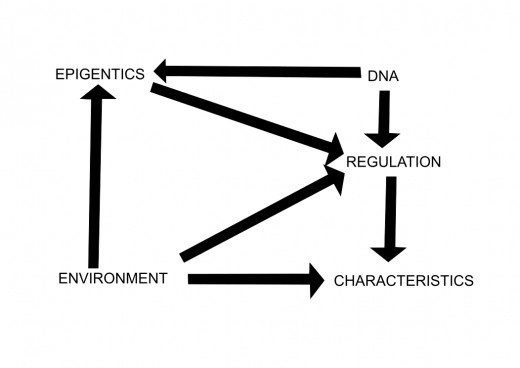
An organism's characteristics are controlled by DNA, environment and epigentics, which themselves interact.
Epigenetics is a product of DNA and therefore likely to vary between individuals.
Humans confuse matters by learning, working things out and telling each other things. This is important in determining the genetics of psychological factors (e.g. do members of a certain group tend to do badly in school because of genetics, how their ancestors were treated altering their epigentics, because of how their parents have treated them or because teachers expect them to do badly?).
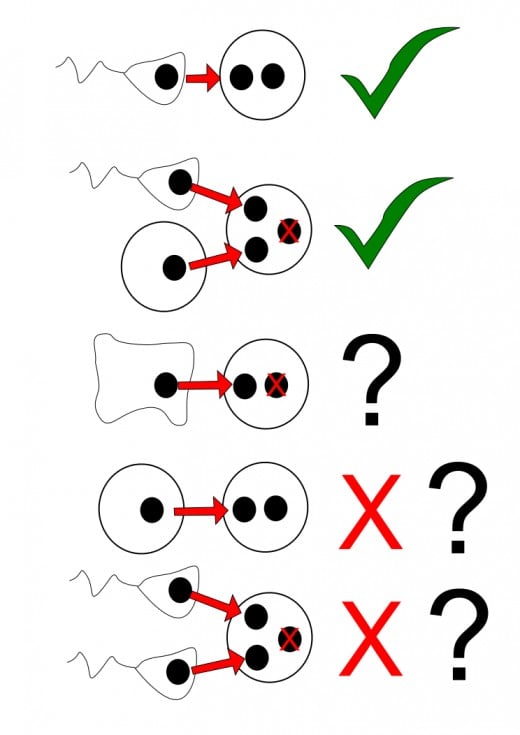
Epigenetics, in mammals, prevents egg cells from developing if they contain two egg cell nuclei or sperm cell nuclei. The egg cell will only develop if it contains an egg cell nucleus and a sperm cell nucleus (or possibly a single diploid nucleus from a non-gamete cell). AFAIK two egg cell or two sperm cell nuclei has only tried in mice, not humans. Egg and sperm nuclei has been done a lot in humans. Using a nucleus from one woman's egg cell and a donated egg cell from another woman with the nucleus removed, plus a sperm nucleus, has been used to allow a woman with a mitochondrial disease to produce a healthy child who's her genetic offspring. Replacing an egg nucleus with a somatic cell nucleus has been used to clone some mammals but there are no reliable reports of it being tried in humans. It's thought this is why there are no virgin births in mammals (only one but that was a miracle). It will be necessary to get round this to produce children for same sex couples (e.g. one parent being Kryptonian).
This has possible questionable political/legal implications – “My epigenetics has been messed up, give me lots of money!” “Your ancestors did bad things to my ancestors so now my people's epigenetics is messed up – give us lots of money!” May be used to argue that children must or must not have certain experiences leading to aggressive media censorship and/or aggressive government control of child rearing.
Epigenetics is poorly understood so it has scope for speculative fiction!
Uses of Epigentics:
-
Explaining differences between identical twins (and other clones).
-
Altering cellular differentiation (e.g. producing a cloned heart from some other type of cell).
-
Treating or causing certain medical problems.
-
Determining somebody's history (and possibly that of their ancestors).
-
Legal and political arguments.
-
Preventing or enabling same-sex couples from producing biological children.
-
Providing a scientific basis for curses, hereditary curses, hereditary memories and reincarnation (only if reincarnated as their own descendent).
Telomeres
These are on the ends of chromosomes and get shorter each time a cell divides (except for germ line and cancer cells). This means cells can only divide so many times. It's thought that preventing or reversing shortening may extend people's lives but it could cause cancer.
Clones from somatic cells start with short telomeres, possibly shortening the clone's life (a plot point in Gundam Seed).
Uses of telomeres:
-
Estimating age.
-
Preventing or slowing aging and extending life.
-
Unusually long telomeres may indicate an immortal.
-
Unusually short telomeres may indicate a clone.
Different Types of Variation
Continuous variation
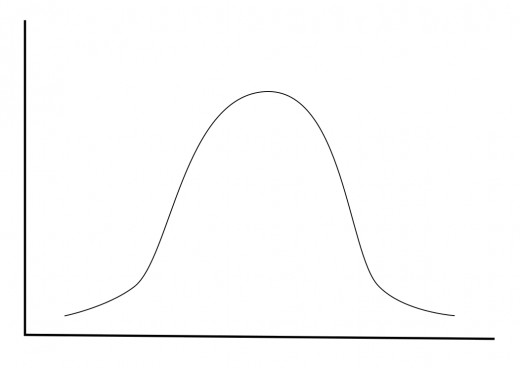
Distribution of characteristics is often illustrated with frequency distribution graphs. These show the strength of characteristic on the X axis and the number of people who have the characteristic at that strength on the Y axis.
It's not at all clear what's going on with continuous variation: is it complicated genetics, completely environmental, a combination of genes and environment?
IQ is famous for showing this sort of distribution.
The Bell Curve: Intelligence and Class Structure in American Life is a 1994 book by psychologist Richard J. Herrnstein and political scientist Charles Murray. This was strongly criticized for being racist and bad science. Lies, damn lies and statistics! Note that neither of the authors was a geneticist! For questionable genetic arguments, bell curves your friend!
Uses of continuous variation:
-
Variation in a characteristic without distinct groupings.
-
A characteristic with a difficult to work out genetic basis.
-
Dubious genetic arguments.
Discontinuous variation

This has a frequency distribution graph with two or more peaks with few or no people between them. In Illustration 4, normal people have low scores (large peak on the left), psychics or witches have high scores (small peak on the right). Alternatively maybe it's the zombie apocalypse and those with a high score are alive and those with a low score are zombies (but zombism usually isn't genetic).
Characteristics with graphs like this are probably genetic; a single gene with two alleles and complete dominance. Three peaks would suggest three alleles with complete dominance or two alleles with partial dominance.
Uses for discontinuous variation:
-
Distinct groups which are (probably) genetic.
-
Easily determined genetic mechanism.
Genealogy
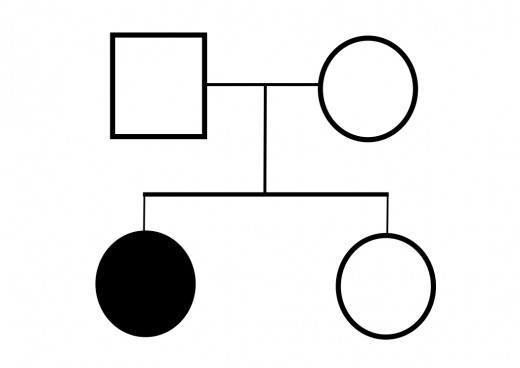
In Illustration 5: Circles = females, squares = males. White = common phenotype. Black = rare phenotype.
If we look at the genealogy of the more extended family, we can get a better idea of what's going on (nuclear family in dotted line).
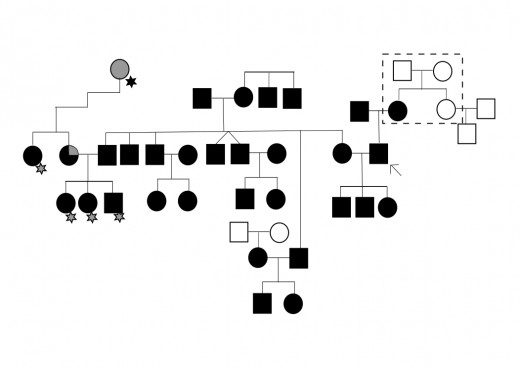
In Illustration 6: Grey with black star = second rare phenotype that seems to be related, unknown if this female also has the black phenotype.
Black with grey segment = seems to have black phenotype but with aspects of grey phenotype.
Black with grey star = seem to have black phenotype but may have aspects of grey.
Two black squares from same point on live above is a pair of identical twins.
Arrow points to the proband (the person who drew our attention to this family).
Clearly this characteristic doesn't cause sterility and people with it can live long enough to produce children. The characteristic clearly affects both sexes. This family consists mostly of people with the rare characteristic, which seems rather odd and they may be some isolated group. People with the rare characteristic also seem prone to marrying each other. There are two cases of fertile females with the rare characteristic being born to couples with the common characteristic.
Uses of genealogies:
-
Determining pattern of inheritance and likely genetic mechanism. Readers can do this, particularly if you have an extended family in your story, so you should check that family relationships make genetic sense.
Parts of Human Genome
The human genome has four main sections which are inherited in different ways, they will be examined in order of increasing complexity.
Y Chromosome -
This consists of a single chromosome and is found only in males and passed from father to son.
Y Chromosomes can be used for:
-
Male-line characteristic only found in males.
-
Tracing ancient male-line ancestry. Many men have Y chromosomes indicating descent from Genghis Khan. Many Jewish men have Y chromosomes thought to show descent from the Jewish priesthood (which was hereditary). Nearly all men are descended from Y chromosome Adam.
-
Determining male-line relationships between males.
Mitochondria:
This is a loop of DNA in the mitochondria, which are the organelles (parts of the cell) responsible for using oxygen. This is the only part of the genome not in the nucleus. Found in both sexes but only passed on by women as the egg cell destroys any mitochondria from the sperm cell which fertilized it. Well usually but it's recently been discovered that mitochondria from the sperm aren't always destroyed. There seems to be an allele that causes this.
More likely than nuclear DNA to be preserved in ancient or very degraded material.
Mitochondria can be used for:
-
Female-line characteristic (probably in both sexes).
-
Tracing ancient female-line ancestry. This was used to identify King Richard III's remains by comparing mitochondrial DNA from his skeleton to those of a female-line descendent of his sister. All people are female line descendants of Mitochondrial Eve.
-
Determining female-line relationships.
-
Getting DNA from degraded material.
Autosomes:
These are a set of 22 chromosomes and everybody has two sets of them. Everybody inherits one set from each parent.
Autosomes can be used for:
-
Characteristic found in equal numbers of both sexes but does not follow the female-line.
-
Characteristic found in equal number of both sexes but is often inherited from the father (will be inherited from the mother equally frequently) or must be inherited from both parents.
-
Characteristic that only works in one sex but can be inherited from either parent (or both parents).
-
Characteristic with dominance relationship between alleles.
-
Tracing general ethnic ancestry.
-
Determining how closely people are related (more common markers, closer relationship).
Chromosomes of each pair exchange parts while making gametes. Therefore alleles of different genes on the same chromosome from different parents could be passed on to the same child. There's less likely to be crossing over if genes are close together. This can be used to map where genes are on chromosomes.
A supergene is group of genes close together on the same chromosome which are inherited like a single gene for a complicated characteristic.
Supergenes can be used for:
-
Complicated system of different types which remain fairly distinct in spite of frequent interbreeding (e.g. Wessens in Grimm, Fey in Lost Girl, everybody in Bojack Horseman).
-
Complicated characteristic which is inherited like a single gene.
Everybody has two copies of all autosomal genes and they may not be the same allele. If they're different, they could have some combined effect. This is called partial dominance. Alternatively, one, which is referred to as dominant, has it's full effect as if the other, referred to as recessive, isn't present. Somebody with both dominant and recessive alleles could pass either to children so parents who both have the dominant characteristic may have children with the recessive characteristic. Parents who both have the recessive characteristic should always have children with the recessive characteristic but there are a few exceptions to this.
Alleles that do something are usually dominant (or partially dominant to each other). Alleles that don't do anything are usually recessive.
If you have a dominant and a recessive allele, you have the dominant phenotype. You need two recessive alleles to have the recessive phenotype.
Many genetic disorders are due to recessive alleles (a dominant allele which prevents anybody with it from breeding will quickly die out). This is why inbreeding tends to be bad (there are probably also psychological issues). Inbreeding also leads to loss of fertility. In the Bible, Abraham's family (up to Jacob's sons) is incestuous and also has fertility problems.
Sarah Conner: People with blood type O have two recessive alleles and must pass one on to each child. People with blood type AB, have two different dominant alleles that are partially dominant to each other. Can only pass an A or B to each child. Therefore an O person and an AB person can only have A or B children, not AB! (Except for rare situations).
Recessive alleles can be used for:
-
Rare characteristic which can be possessed by somebody born to normal parents.
-
Characteristic shared by siblings but not necessarily other relatives.
-
Group who have arranged marriages or inbreeding to produce people with “desirable” recessive trait.
-
Characteristic that appears as a result of inbreeding.
-
Characteristic where two parents who possess it will nearly always produce children who also have it.
Dominant alleles can be used for:
-
Characteristic that runs in families in an obvious way (but people with it stand a chance of producing children with the recessive phenotype).
Complications:
-
Same or very similar recessive phenotype may be due to alleles of different genes. Children of a couple with a recessive phenotype due to alleles of different genes will produce children with the dominant phenotype. If children from such couples produce their own children, on average out of every 16 children, 9 will have the dominant phenotype, three one recessive phenotype, three the other and one whatever you get if you have two copies of both recessive alleles (this is a plot point in this author's Tales of Midbar: Secret Priest).
-
Recessive alleles may back-mutate to produce the dominant phenotype but won't necessarily be quiet the same.
-
Other genes, environment or epigenetics may affect how alleles are expressed.
Sarah Conner: The very rare Bombay phenotype (hh) prevents making A or B antigens even if you have A and/or B alleles so are effectively type O. A person with this who has an A and/or B allele could have an AB child but the right sperm would have to fertilize the right egg.
X Chromosome:
A single chromosome, males have one and females have two. Crossing over only occurs in females (a bit of crossing over between small regions of X and Y chromosomes does occur in males). Females therefore have two copies of each gene and males one. This chromosome is thought to have a lot of genes for social skills and intelligence explaining the statistical difference between IQ's of the two sexes.
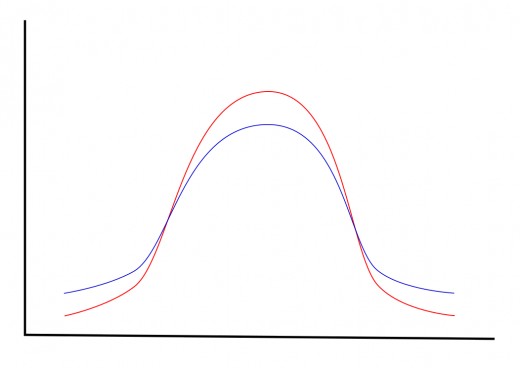
Both sexes have an average IQ of 100 but IQ tests have been rigged like this. On early IQ tests, women scored higher. Sexes have somewhat different mental skills so it's hard to compare but we can usually have fairly sensible conversations with each other suggesting that intelligence is, on average, about the same in both sexes. Women are more likely to be average than men. This is thought to be due to intelligence genes on women's two X chromosomes averaging out while men are more likely to get an extreme combination. X-linked intelligence genes are presumably partially dominant or with about equal numbers of smart dominant and dumb dominant or one sex would be a lot smarter than the other.
X linked genes can be used for:
-
Characteristic that's commoner in one sex (probably males).
-
Having a female character with a characteristic that's normally found only in males (perhaps the country's only female warlock but you'd need a reason for warlocks not to father children with female relatives of warlocks).
-
Characteristic only present in females because it requires two different X-linked alleles.
-
Could be used to trace ancestry but isn't.
-
Determining how people are related (e.g. sister or daughter? - A woman's sister will share one X chromosome and about half of the other. Her daughter will have one chromosome composed of parts of both of the mother's.)
-
Determining mental characteristics.
-
Estimating how well people are likely to get on with each other. Possibly useful for matchmaking but this requires knowing the dominance relationships as you'll probably be mostly pairing people with different numbers of X chromosomes.
Determining part of genome from genealogy
Refer to the extended family genealogy (Illustration 6) earlier in this article.
How is the rare (black) characteristic in the genealogy inherited (assume all parentage correct and no mutation)?
There are two females with the rare characteristic born to normal parents. The only explanation for this is an autosomal recessive. There's another recessive phenotype in the family, a red haired couple with seven red haired children. It's like this was made up by somebody who wanted to tell us the rare characteristic is recessive! The proband is Harry Potter. The rare characteristic is being a witch or wizard.
The quarter grey woman is Fleur, a witch who's wand contains a feather from her grandmother who's a veela. There's not much information on veelas. They all seem to be female. Do they normally marry wizards? This is a complicated characteristic, likely to be a supergene. Is Fleur a full Veela? Are all Veelas witches?
You're probably wondering about squibs (people without magic born to magical parents). They're slightly different from muggles (seem to have some sort of cat symbiosis and can see dementors). This suggests they're due to back-mutation, modifier genes or environment factors. We're not told much about them.
Bloodlines
Before getting into this, I want to make it clear that I don't agree with incest and have serious issues with arranged marriages.
What is a “bloodline”? It's a term you hear people using but it doesn't seem to have a clear meaning. It presumably starts with somebody people think is special so they track their descendants, thinking they'll also be special. They could continue following the descendants long after it becomes genetically meaningless (but does it have to make genetic sense for a curse or prophesy to apply?).
To be meaningful, a bloodline must have at least one of the following:
-
Inbreeding. This is genetically unwise. It's also likely to require arranged marriages and people of the blood line may not cooperate.
-
Follow the male line (Y chromosome) but this will cease making sense if it goes through a female generation (e.g. following Biblical inheritance laws where a daughter can inherit in the absence of a son).
-
Follow the female line (mitochondria) but this will cease making sense if it goes through a male generation.
-
Following a, probably rare, dominant allele. Assuming the blood line is breeding with people with the recessive trait, there's a danger of failing to pass on the dominant allele. Could have arranged marriages, inbreeding or try to have bloodline members produce lots of children to make this less likely.
-
Selective breeding for characteristic (possibly due to a recessive allele). This is likely to require arranged or semi arranged marriages (where people are given a group of potential partners to choose from, such as sending the children to a special high school). Biblical prophets and Wizarding families seem to do this.
Any of these could fall foul of marriage laws, non-scientific inheritance laws and uncooperative bloodline members not to mention plagues, wars and anything else that could complicate reproduction or keeping track of families.
History, and to some extent the present day, is littered with incestuous monarchies, arranged marriages and particular emphasis on male line descendants. I can't help wondering how much of this started to preserve a meaningful bloodline. The practise my well have continued long after the objective had been forgotten. This suggests people in ancient times may have known more genetics than we'd have expected. If the Holy Grail is a bloodline, then the genealogies would need to be updated every 20 years or so and it may require arranged marriages and selective breeding to keep it meaningful.
Uses of bloodlines:
-
Making certain people “special” (monarchs or subjects of curses or prophecies).
-
Group having a culture of incest and/or arranged or semi-arranged marriages.
-
Reason for things (monarchies, houses etc.) to be inherited down the male or female line.
-
A family having some unusual genetic characteristic, which may be necessarily to be the heir.
Hybrids
Hybrids result from interbreeding between any groups with genetic differences. Biology restricts hybridization to fairly closely related types. Here we'll just be considering hybrids between different human or near-human groups where there are multiple genetic differences spread around the genome, not just one gene or supergene.
First generation hybrids (F1) are fairly consistent and tend to be stronger and healthier than their parents (hybrid vigour). Hybrid vigour may be why the nephilim were great heroes.
After the first generation (F2, backcrosses etc.), the various genes are inherited separately depending on where they are in the genome, resulting in recombination. Children of a hybrid, may bare little resemblance to each other, even looking like different races. You could get any combination of the characteristics of the parent types or intermediate characteristics if they're partially dominant or controlled by more than one gene. Hybrids between human races just produces people with unusual combinations of characteristics. With elves, Denisovans (there really is a case of a female apparent almas, Russian yeti, having children with H. sapiens) or aliens it could get more interesting, with people who look like humans but have elf magic or vice versa or some other unlikely and plot-relevant combination of characteristics.
A group of hybrids is called a swarm and may develop into a stable race or species over multiple generations, consistent with Shadow Hunters (modern descendants of the ancient nephilim).
I don't have anything against interbreeding between races. The following is just discussing how you can plausibly have multiple races in a fictional setting.
If there is more than one race in an area and nothing to prevent interbreeding (at least most the time) a couple of things could happen. A minority race will disappear but some people will probably continue to have characteristics of them. It's thought this may have been what happened to the Neanderthals, rather than being killed they were swamped by larger numbers of H. sapiens with whom they interbred. Now all non-African H. sapiens have about 1-2% Neanderthal DNA and you sometimes see people with big noses, eye brow ridges and/or no chins.
If two races start interbreeding with roughly equal numbers, they will become a single, variable race.
The point I'm trying to make here is that if your fictional setting has more than one race, there must have been something that mostly prevented interbreeding, at least until near the time your story takes place. Perhaps the races mostly live in different places. Perhaps one race has just moved into the area. Perhaps it's illegal for them to interbreed. Perhaps they're different religions who have prohibitions against marrying outside their faiths. Perhaps they speak different languages making it hard to form serious relationships. There could be some biological reason, like being physically unable to interbreed of having different courtship instincts. A biological anti-interbreeding mechanism would make the two groups different species rather than races of the same species, if that's important to you. Or you could make them differ by a single allele or supergene so they remain distinct in spite of interbreeding but that's not the situation we're considering here.
Hybridization can be used for:
-
Realistic consequences of interbreeding (never seen this done well).
-
Producing distinctive looking characters.
-
Producing siblings who look very different, which may confuse people.
-
For hybrids with elves, aliens etc. can produce people with strange powers or combinations of powers or strange combinations of powers (or lack of them) and appearance.
Chimeras
These have two or more genetically different cell lines. Human chimeras can be produced naturally, a woman gets pregnant with fraternal twins but the embryos combine to produce one baby with two genetically different cell lines. Chimeras can also be produced artificially, by combining cells from two or more embryos (not necessarily of the same species) to make one.
A human/alien chimera is probably more plausible than a human x alien hybrid.
If chimeras reproduce, they're children will be the genetic children of their gonads (unless there's some mechanism to pass on DNA from both cell lines, which would only be the case in an artificial chimera).
Sarah Conner: could be a chimera with type O bone marrow (which makes her blood) and A, B or AB ovaries but the right sperm still has to fertilize the right egg to produce an AB child.
Chimeras can be used for:
-
Characters who have children (or produce sperm) inconsistent with their characteristics.
-
People with strange powers.
Conclusion
This may seem daunting but, unless you're writing something like Orphan Black or Regenesis, you probably only need a few bits of this. You may think you don't need genetics at all but then you have a family and want their characteristics to be consistent with their relationships (or not because somebody isn't related how they're supposed to be), somebody needs a blood transfusion in an awkward situation or a DNA test has shocking results. Perhaps you should keep this as a reference for when you're figuring out the marriage rules for sorcerers, or need to figure out how lycanthropy is inherited in your universe or just making people's looks consistent with their biological relationships.

